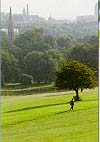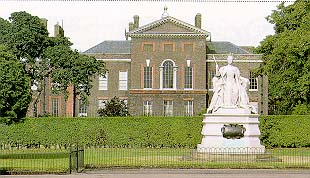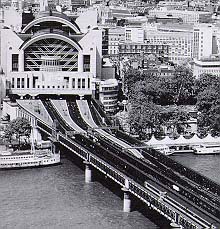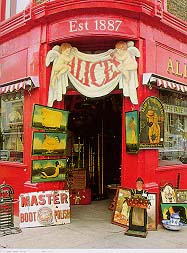|
Image: from the
cover of The Lonely Londoners Harlow, Essex: Longman, 1956
The
Lonely Londoners :
 The
novel in general: The
novel in general:
-
Why are these Caribbean Londoners lonely? Do they have a way out
of their sense of loneliness and disintegration? (clues: the description
of the labour office p. 45)
-
Can you find, as Selvon points out, an alternation of Standard English
and Trinidadian patois? (
 His own views.)
His own views.)
-
What do you think Selvon wants to include those lazy and irresponsible
womanizers such as Cap? What do you think about the female characters
role in general? (
 See a critic's view.)
See a critic's view.)
 Section 1 pp. 23 - 35:
Moses and the scene at Waterloo station
Section 1 pp. 23 - 35:
Moses and the scene at Waterloo station
-
Upon first reading, you must have come across some
non-Standard usages of English. Can you identify them?
How is London fog described?
-
What kind of person is Moses? How is
he different from the other people from the Caribea area? How does
he relate to them (e.g.pp. 25. like "a welfare officer"; p. 26 "this sort
of slackness"; p. 27 the Jamaican landlord)? Is there any significance
to his name?

Waterloo International Terminal;
p. 113
|
-
Tolroy: How kind of immigrant is Tolroy?
How is he different from Moses (pp. 26-27 ).
-
The newspaper reporter: Why does Moses
pretend that he is a new immigrant to the reporter? Why does the
reporter stop interviewing Moses in the middle? How does he deal
with the Tolroy family (pp. 30-32)? How do they respond to him?
And how are they presented on newspaper the next day?
|
-
The Caribbean immigrants: Judging
from the introduction to the book, the setting of the novel should be in
1950's, when large flow of Caribbean immigrants with their extended families
arrive in U.K., and when the open-door policy started to be questioned.
What are the situations of the immigrants? What do they expect of
U.K. and how are they recieved?
-
Henry Oliver (Sir Galahad):
 Section
2 pp. 35 - 47:
(Moses &) Galahad Section
2 pp. 35 - 47:
(Moses &) Galahad
-
What kind of contrast is shown between Galahad and
Moses in their dialogue (pp. 38-41)?
-
Galahad immpresses Moses as being independent and
courageous("on the ball," "have guts"p. 38). But what happens to
him when he goes out to look for a job? Why does he feel that
he loses everything when being lost on the street (p. 42)?
 Section
3 pp. 47 - 61:
Captain (a Nigerian) Section
3 pp. 47 - 61:
Captain (a Nigerian)
-
From this chapter on, Selvon presents all sorts
of characters that live in a hostel. The sections seem unconnected
with each other, but you will get to understand the "lonely Londoners"
more and more by putting different lives together and comparing
them.
-
After the very heroic Galahad, we come across this
wandering Nigerian, Captain, who surely is not the type of hardworking
and responsible immigrant. Try to describe--and understand-- his
personalities.
-
Here, as well as in the next episode about Bart,
Selvon does not want us to have a uniformly positive picture of the Caribbeans.
What, then, does he try to do? (Of course, you won't be able to fully
answer this question until you finish the novel. Wait till the episode
of Captain with his pigeons.)
 Section
4 pp. 61 - 67:
Bart Section
4 pp. 61 - 67:
Bart  Section
5 pp. 67 - 71: Lewis Section
5 pp. 67 - 71: Lewis
-
Women: In these two sections, as well as the
previous one, we get to see several different ways in which the male characters
(Cap, Daniel, Bart and Lewis) deal with their women. How do they
differ from each other? Would you call all of them male chauvinists?
-
Money: Why is Bart so obsessed with money?
What does money represent for him? What is Lewis's obsession?
 Section
6 pp. 71 - 83:
Tanty Section
6 pp. 71 - 83:
Tanty
-
Pay attention to the description of the neighborhood
and London in this section.
The Haves
and Have-Nots

Hampstead Heath
|

Kensington Pallace |
?
Harrow Rd (The Lonely Londoners 73-74)
|
-
Does the description of Tanty make you change your
view about Selvon's gender policy?
 Section
7 pp. 83 - 93 : [summer time] Galahad Section
7 pp. 83 - 93 : [summer time] Galahad
-
Here we see Galahad's experience of racism.
Why does Selvon wait till after the middle of the novel to present this?
-
Why does Galahad insist on meeting his German girlfriend,
Daisy, in places such as Charing Cross and Piccadilly Tub Station?
Why doe he like to take her to Piccadilly Circus (84-85)? Why does
he care so much about his dressing? Is all of this related just to
his courting skills?

Embankment place: Charing
Cross 121
". . . when he say 'Charing
Cross,' when he realise that is he, Sir Galahad, who going there, near
that place that everybody in the world know about . . . he feel like a
new man" (84). |
Piccadilly
Circus; 89
 ". . . that circus have
a magnet for him, that circus represent life, that circus is the beginning
and the ending of the world" (90)
". . . that circus have
a magnet for him, that circus represent life, that circus is the beginning
and the ending of the world" (90)
-
How is all he intends defeated by the little child
he meets?
-
How does he respond to this discrimination against
the blacks? Why can he put his thoughts out of his mind as he goes
to meet Daisy at the Circus (89)?
-
Gender relations:
How
does Galahad deal with Daisy? How does he respond to Daisy's comment
on his language? Why does he call it a "battle royal" (93)?
|
 Section
8 pp. 93 - 67:
Big City Section
8 pp. 93 - 67:
Big City
-
What are Big City's dreams? Are they at all
possible?
-
March Arch speech
-- pp. 98-99. What do you think about the interchange between Big
City and Sir Galahad? Are there symbolic meanings?

Portobello Rd., Nottinghill
Gate; 215.
|
"Where are you going, Big
City?"
"Nottingham Gate.."
"Is not Nottingham, boy,
is Notting Hill."
"You trying to -- me up?"
(95)
(Notting Hill,
the center of Caribbean community. )

Notting Hill carnival; 57
|
 Section
9 pp. 101 - 110:
An overiew of the Caribbeans in summer Section
9 pp. 101 - 110:
An overiew of the Caribbeans in summer
-
Here there are two distinct changes in style: 1.
the address to "you" and 2. the lack of punctuation. Why?
-
How is the summer in the park (Hyde Park) presented?
Why does Selvon focus on the courting between the boys and the girls?
Besides the general description, what about the several examples of Moses'
experience (with a woman who fakes being ill; a gay; a Blondie and a pansy).
-
How does this section reveal about the relationships
between black males and white women (108)?
 Section
10 pp. 110 -122:
Five Past Twelve vs. Harris; Tanty vs. Harris Section
10 pp. 110 -122:
Five Past Twelve vs. Harris; Tanty vs. Harris
 Section
11 pp. 122 - 134:
Galahad; Moses and G, reflecting on their stay in London Section
11 pp. 122 - 134:
Galahad; Moses and G, reflecting on their stay in London
 Kensington gardens in snow 59
Kensington gardens in snow 59 |
-
Do you think that Galahad is a "cruel beast" in catching and eating the
pigeons (pp. 124-25)?
-
What's the importance of the story of Brackley back home (pp. 127-28)
-
What is Moses' experience in London like (pp. 129, 130-131)? Why
does Moses stay in London for ten years without going back? Why does
he still say he wants to go back? Do you see him as a permanent
sojourner who is forever isolated in the host society? How about
the fact that he votes for the Labour party every year?
-
Is Moses' reasons for not getting married justified? Consider also
Joseph's story (pp. 130-31).
|
 Section
12 pp. 134 - 37: Cap and the seagulls Section
12 pp. 134 - 37: Cap and the seagulls
 Section
13 pp. 137 - 42:
Moses, the boys and the City Section
13 pp. 137 - 42:
Moses, the boys and the City
-
What do you think about the role of Moses among the
boys? And his views of them (having "a forlorn shadow of doom fall
on all of the spades" 141)?
-
What is the sense of "something solid" that he feels?
-
What role do women play among these lonely londoners?
|



![]() Places
:
Places
: